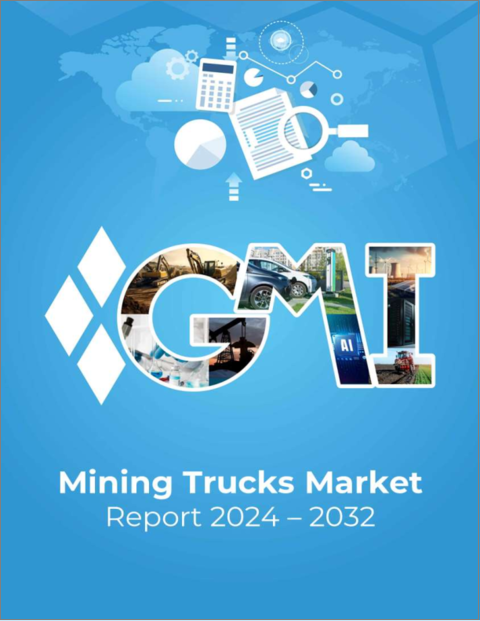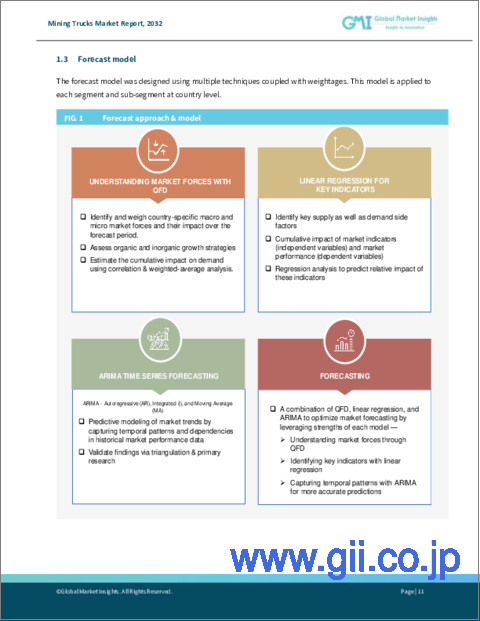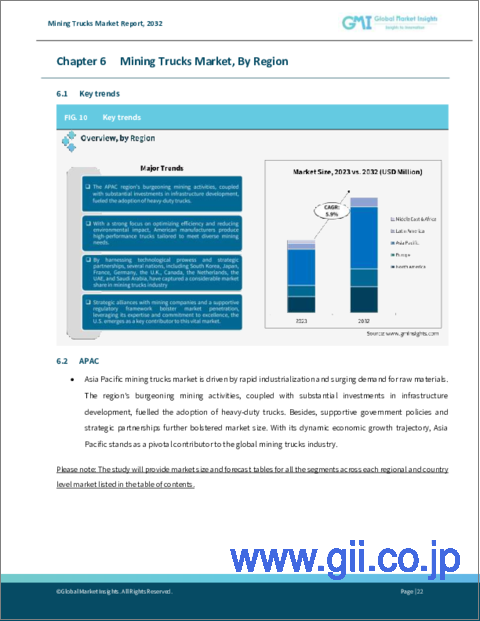|
|
市場調査レポート
商品コード
1529001
採鉱用トラックの市場規模:オペレーションモード別、トラック別、積載量別、推進別、予測、2024年~2032年Mining Trucks Market Size - By Mode of Operation (Autonomous, Manual), By trucks (Rigid Frame Haul Trucks, Articulated Haul Trucks, Off-Highway Trucks, Underground Mining Trucks), By Payload Capacity, By Propulsion & Forecast, 2024 - 2032 |
||||||
カスタマイズ可能
|
|||||||
| 採鉱用トラックの市場規模:オペレーションモード別、トラック別、積載量別、推進別、予測、2024年~2032年 |
|
出版日: 2024年05月10日
発行: Global Market Insights Inc.
ページ情報: 英文 340 Pages
納期: 2~3営業日
|
全表示
- 概要
- 目次
採鉱用トラックの市場規模は、建設、製造、技術など様々な産業における鉱物・金属需要の増加に牽引され、2024年から2032年にかけてCAGR 5.5%超が見込まれています。
世界の都市化と工業化が進む中、鉄鉱石、銅、石炭、その他の必須鉱物のような原材料の必要性が高まっています。Worldbank.orgによると、世界の都市人口は2045年までに60億人に達すると予測されています。この需要により、鉱山会社は操業を拡大し、より効率的で大容量の採鉱用トラックに投資して生産性を向上させ、操業コストを削減する必要に迫られています。
インフラ開発への実質的な投資が世界的に増加していることも、市場の成長を促進するでしょう。政府と民間部門は、道路、橋、空港、住宅・商業ビルを含む大規模インフラ・プロジェクトに多額の投資を行っており、これらは採鉱活動から調達される広大な建設資材を必要とします。
採鉱用トラック産業は、オペレーションモード、トラック、積載量、推進、地域に分けられます。
トラックに基づくと、オフハイウェイト・トラック・セグメンテーションの市場規模は、課題である採鉱環境において大量の採掘材料を効率的に輸送する上で重要な役割を果たすため、2024年から2032年の間に著しい成長を示すと予測されます。オフハイウェイ・トラックは、優れた耐久性、高い積載量、強化された操縦性を提供するため、険しい地形や過酷な条件下で作動するよう特別に設計されています。
ハイブリッド電気推進セグメントによる採鉱用トラック市場は、運転効率を高めながら燃料消費と排出を大幅に削減する能力により、2032年まで大きな成長率を記録するでしょう。ハイブリッド電気採鉱用トラックは、従来のディーゼル・エンジンと電気動力を組み合わせることで、より低い運転コストと環境フットプリントの削減をもたらします。ハイブリッド電気トラックはまた、トルクと動力供給の点で改善された性能を提供し、採鉱作業の厳しい条件に適したものとなっています。
北米の採鉱用トラック産業規模は、テクノロジー、製造業、再生可能エネルギーを含む様々なセクターで使用される鉱物・金属に対する旺盛な需要に煽られ、2032年までまずまずの成長を示すでしょう。採掘作業における自動化とデジタル技術の採用の増加は、この地域における採鉱用トラックの効率と生産性を高め、近代的採掘プロジェクトに不可欠なものにしています。
目次
第1章 調査手法と調査範囲
第2章 エグゼクティブサマリー
第3章 業界洞察
- エコシステム分析
- サプライヤーの状況
- メーカー
- 技術プロバイダー
- 原材料・部品サプライヤー
- 利益率分析
- 技術革新の状況
- 特許分析
- 主要ニュース&イニシアチブ
- 規制状況
- 影響要因
- 促進要因
- 世界の鉱物需要の増加
- 採掘事業の拡大
- 技術進歩の増加
- 自律走行型採鉱用トラックに対する需要の高まり
- 業界の潜在的リスク&課題
- 規制の変更により、トラック・メーカーのコンプライアンス・コストが増加
- 変動する商品価格が鉱業投資の決定に影響
- 促進要因
- 成長可能性分析
- ポーター分析
- PESTEL分析
第4章 競合情勢
- イントロダクション
- 企業シェア分析
- 競合のポジショニング・マトリックス
- 戦略展望マトリックス
第5章 市場推計・予測:オペレーションモード別、2021年~2032年
- 主要動向
- 自律型
- 手動
第6章 市場推計・予測:トラック別、2021年~2032年
- 主要動向
- リジッドフレームホウルトラック
- 多関節ホウルトラック
- オフハイウェイトラック
- 地下採鉱用トラック
第7章 市場推計・予測:積載量別、2021年~2032年
- 主要動向
- 100トン未満
- 100~200トン
- 200~300トン
- 300トン以上
第8章 市場推計・予測:推進別、2021年~2032年
- 主要動向
- ディーゼル
- ハイブリッド電気
- その他
第9章 市場推計・予測:地域別、2021年~2032年
- 主要動向
- 北米
- 米国
- カナダ
- 欧州
- 英国
- ドイツ
- フランス
- スペイン
- ロシア
- その他欧州
- アジア太平洋
- 中国
- インド
- 日本
- 韓国
- ニュージーランド
- 東南アジア
- その他アジア太平洋地域
- ラテンアメリカ
- ブラジル
- メキシコ
- アルゼンチン
- その他ラテンアメリカ
- 中東・アフリカ
- UAE
- 南アフリカ
- サウジアラビア
- その他の中東・アフリカ
第10章 企業プロファイル
- Atlas Copco
- BELAZ
- Caterpillar Inc.
- Daimler AG
- Doosan Corporation
- Epiroc AB
- Hitachi Construction Machinery Co., Ltd.
- Hyundai Construction Equipment
- Komatsu Ltd.
- Liebherr Group
- Navistar
- Paccar Inc
- Sandvik AB
- SANY Group
- Terex
- Terex Corporation
- Traton
- Volkswagen
- Volvo Group
- XCMG Group
Mining trucks market size is expected to witness over 5.5% CAGR between 2024 and 2032 driven by the increasing demand for minerals and metals across various industries, such as construction, manufacturing, and technology. With global urbanization and industrialization continuing to rise, there is a heightened need for raw materials like iron ore, copper, coal, and other essential minerals. As per Worldbank.org, the global urban population is projected to reach 6 billion by 2045. This demand is compelling mining companies to expand their operations and invest in more efficient and larger-capacity mining trucks to improve productivity and reduce operational costs.
Rising substantial investments in infrastructure development globally will also fuel market growth. Governments and private sectors are investing heavily in large-scale infrastructure projects, including roads, bridges, airports, and residential and commercial buildings, which require expansive construction materials sourced from mining activities.
The mining trucks industry is divided into modes of operation, trucks, payload capacity, propulsion, and region.
Based on trucks, the market size from the off-highway trucks segment is slated to depict significant growth between 2024 to 2032 due to their critical role in efficiently transporting large volumes of extracted materials in challenging mining environments. Off-highway trucks are specifically designed to operate in rugged terrains and under extreme conditions to offer superior durability, high payload capacity, and enhanced maneuverability.
Mining trucks market from the hybrid electric propulsion segment will record a significant growth rate through 2032 owing to its ability to significantly reduce fuel consumption and emissions while enhancing operational efficiency. Hybrid electric mining trucks combine traditional diesel engines with electric power, resulting in lower operating costs and reduced environmental footprints. Hybrid electric trucks also offer improved performance in terms of torque and power delivery, making them more suitable for the demanding conditions of mining operations.
North America mining trucks industry size will exhibit decent growth through 2032 fueled by the strong demand for minerals and metals used in various sectors, including technology, manufacturing, and renewable energy. The increasing adoption of automation and digital technologies in mining operations is enhancing the efficiency and productivity of mining trucks in the region, making them indispensable for modern mining projects.
Table of Contents
Chapter 1 Methodology & Scope
- 1.1 Market scope & definition
- 1.2 Base estimates & calculations
- 1.3 Forecast calculation
- 1.4 Data sources
- 1.4.1 Primary
- 1.4.2 Secondary
- 1.4.2.1 Paid sources
- 1.4.2.2 Public sources
Chapter 2 Executive Summary
- 2.1 Industry 360° synopsis, 2021 - 2032
Chapter 3 Industry Insights
- 3.1 Industry ecosystem analysis
- 3.2 Supplier landscape
- 3.2.1 Manufacturers
- 3.2.2 Technology providers
- 3.2.3 Raw material and component suppliers
- 3.3 Profit margin analysis
- 3.4 Technology & innovation landscape
- 3.5 Patent analysis
- 3.6 Key news & initiatives
- 3.7 Regulatory landscape
- 3.8 Impact forces
- 3.8.1 Growth drivers
- 3.8.1.1 Increased demand for minerals globally
- 3.8.1.2 Expansion of mining operations
- 3.8.1.3 Increasing technological advancements
- 3.8.1.4 Rising demand for autonomous mining trucks
- 3.8.2 Industry pitfalls & challenges
- 3.8.2.1 Regulatory changes increase compliance costs for truck manufacturers
- 3.8.2.2 Fluctuating commodity prices affect mining investment decisions
- 3.8.1 Growth drivers
- 3.9 Growth potential analysis
- 3.10 Porter's analysis
- 3.10.1 Supplier power
- 3.10.2 Buyer power
- 3.10.3 Threat of new entrants
- 3.10.4 Threat of substitutes
- 3.10.5 Industry rivalry
- 3.11 PESTEL analysis
Chapter 4 Competitive Landscape, 2023
- 4.1 Introduction
- 4.2 Company market share analysis
- 4.3 Competitive positioning matrix
- 4.4 Strategic outlook matrix
Chapter 5 Market Estimates & Forecast, By Mode of Operation, 2021 - 2032 ($Bn, Units)
- 5.1 Key trends
- 5.2 Autonomous
- 5.3 Manual
Chapter 6 Market Estimates & Forecast, By Trucks, 2021 - 2032 ($Bn, Units)
- 6.1 Key trends
- 6.2 Rigid frame haul trucks
- 6.3 Articulated haul trucks
- 6.4 Off-highway trucks
- 6.5 Underground mining trucks
Chapter 7 Market Estimates & Forecast, By Payload Capacity, 2021 - 2032 ($Bn, Units)
- 7.1 Key trends
- 7.2 Less than 100 tons
- 7.3 100-200 tons
- 7.4 200-300 tons
- 7.5 Above 300 tons
Chapter 8 Market Estimates & Forecast, By Propulsion, 2021 - 2032 ($Bn, Units)
- 8.1 Key trends
- 8.2 Diesel
- 8.3 Hybrid electric
- 8.4 Others
Chapter 9 Market Estimates & Forecast, By Region, 2021 - 2032 ($Bn, Units)
- 9.1 Key trends
- 9.2 North America
- 9.2.1 U.S.
- 9.2.2 Canada
- 9.3 Europe
- 9.3.1 UK
- 9.3.2 Germany
- 9.3.3 France
- 9.3.4 Spain
- 9.3.5 Russia
- 9.3.6 Rest of Europe
- 9.4 Asia Pacific
- 9.4.1 China
- 9.4.2 India
- 9.4.3 Japan
- 9.4.4 South Korea
- 9.4.5 ANZ
- 9.4.6 Southeast Asia
- 9.4.7 Rest of Asia Pacific
- 9.5 Latin America
- 9.5.1 Brazil
- 9.5.2 Mexico
- 9.5.3 Argentina
- 9.5.4 Rest of Latin America
- 9.6 MEA
- 9.6.1 UAE
- 9.6.2 South Africa
- 9.6.3 Saudi Arabia
- 9.6.4 Rest of MEA
Chapter 10 Company Profiles
- 10.1 Atlas Copco
- 10.2 BELAZ
- 10.3 Caterpillar Inc.
- 10.4 Daimler AG
- 10.5 Doosan Corporation
- 10.6 Epiroc AB
- 10.7 Hitachi Construction Machinery Co., Ltd.
- 10.8 Hyundai Construction Equipment
- 10.9 Komatsu Ltd.
- 10.10 Liebherr Group
- 10.11 Navistar
- 10.12 Paccar Inc
- 10.13 Sandvik AB
- 10.14 SANY Group
- 10.15 Terex
- 10.16 Terex Corporation
- 10.17 Traton
- 10.18 Volkswagen
- 10.19 Volvo Group
- 10.20 XCMG Group






